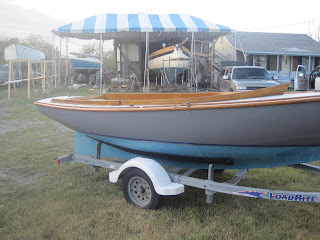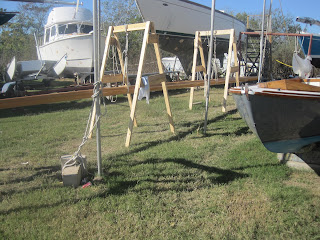Dimensions
The mast is Sitka Spruce and measures 45 ft from the top of the ballast or 39 feet from the main deck. The diameter at the base is 6 3/4 inches. At the 32 foot mark the diameter tapers down to 3 inches. The stays and runners will be 9mm synthetic Dyneema from Coligo. The gooseneck will be 9 ft 4 inch above the keel step or 40 inches above the main deck or 22 inches above the house top.
Topsail Leader Line
A 9mm Dyneema leader line will attach to the top mast band to support the the bottom half of the topsail luff. A line terminator will connect to the lower eye on the aft side of the mast through a pair of 5/8 inch toggles. The terminator will fit the jaws of a 5/8 inch toggle but not the 1/2 inch toggle. With two toggles the leader line can align itself on deck transversely and longitudinally. After the boom is rigged up I will find a good deck location and attachment point that doen't interfere with the swing of the boom.
According to Brion Toss this leader line will make it much easier to strike the topsail regardless of wind direction. Brion adds that, “It will keep the sail inboard and bundled up whether it is going up or down. In addition, of course, the jackstay, properly tensioned, allows for a better to-weather shape, without an absurdly tensioned halyard. In addition to supporting the luff of the topsail the jackstay will be used to set a trysail on hanks.
According to Brion Toss this leader line will make it much easier to strike the topsail regardless of wind direction. Brion adds that, “It will keep the sail inboard and bundled up whether it is going up or down. In addition, of course, the jackstay, properly tensioned, allows for a better to-weather shape, without an absurdly tensioned halyard. In addition to supporting the luff of the topsail the jackstay will be used to set a trysail on hanks.
Headstay
Just below the spinnaker halyard block the 9 mm Dyneema Dux headstay will be attached to the mast on a spliced soft eye against a bronze hound on the aft side of the mast 6 feet below the top of the mast at the 39 foot mark.. On deck a 1/2 inch distributor will pin to the middle eye of the cranse iron through a 1/2 inch toggle. The distribtor will be lashed to the line terminator.
Upper ShroudsThe upper mast band is positioned 2.5 feet further down at 36.6 feet on the mast. The upper line terminator will pin to the toggle not directly to the mast band so the shroud can line up longitudinally and transversely. On deck the 1/2 inch chain plate distributor will pin directly to the chain plate. The distributor and the terminator should be about 18 inches apart, connected by a 4 part 1/4 inch lashing. The jib halyard block and the upper peak halyard block will be attached to this same mast band.
Backstays
Next at 35 feet another split mast band will support the two 9 mm Dyneema Dux backstays and the lower peak halyard block. At the top the backstay line terminators will shakle or lash to the aft eyes of the split mast band. The lower terminator will pin to a whip consisting of two single blocks one with a becket. The falls will lead to the jib sheet winches.
Forestay
A third split mast band will be positioned four feet three inches further down at the 31 foot level to support the Dyneema Dux forestay on the forward face and the throat halyard block on an aft facing crane. The tang that faces down in the photo below has one 1/2 inch eye for the staysail halyard block. I will drill a second one above it for the forestay itself. I will also need a 1/2 inch jaw by jaw toggle to connect the line terminator to the tang. A single block for the staysail halyard will attach direct to the lower eye.
The shroud will attach directly to the gammon iron with a 1/2 inch line terminator on a jaw to jaw toggle. The toggle lets me use 1/2 inch fittings instead of 3/4 inch, allows more movement and turns the line terminator so it faces fore and aft. An exact length forestay eliminates the stack of fittings and lashings that would otherwise prevent the stays'l from falling all the way to deck level when struck. The other option is to put a turnbuckle up at the mast band. It would be a pain to get at but I am assuming you would only have to adjust one time. Once the rig is tuned the length of this stay will not change. Any fine tuning of this stay can be done on deck by adjusting the aft lowers and/or the runners.
Lower Shrouds
The lowest band is positioned just under the spreader at the 28.5 foot level on the mast. The lowers attach to the toggles on a 1/2 inch line terminator. The port and starboard topping lift lines will fall from two Coligo static blocks lashed to the eye bolts on this same mast band. On deck the 1/2 inch chain plate distributor will pin to the forward eye of the chain plate. The topping lift block will attach to the aft eye on the same chain plate. And like the cap shrouds the distributor and the terminator for the lowers will be about 18 inches apart and connect with a 4 part 1/4 inch lashing.

















